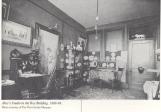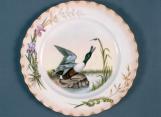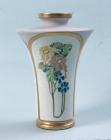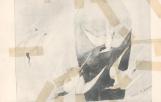8
China painting as women's artChina painting was an extremely popular occupation among women when Alice Egen learned to do it in the 1890s. As The Art Journal reported in 1872: "Designing seems to offer particularly suitable work for women. To whom should we so confidently apply for all that concerns the beautifying of home life as to the presiding spirit of the home?...There is perhaps no branch of art-work more perfectly womanly and in every way desirable than painting on china.'(1)
There were relatively few occupations that were regarded as acceptable for respectable women in the late 19th century. Among the few kinds of work that were regarded as appropriate were school teaching and quasi-domestic jobs such as dressmaking and running boarding houses. Some 19th-century middle-class women turned to writing as a career, and an even smaller group chose china painting. Paid work for women was more acceptable when it was done for women customers and if it had a connection to the household. Thus, teaching children was regarded as being like mothering, and china painting was seen as improving the beauty of the home.
(1) Pamela Gerrish Nunn, Victorian Women Artists. (London: Women's Press, 1987)
10
The State Dinner Services (Game plate)In 1896 Alice Egan was commissioned by the Women's Art Association of Canada to paint twelve plates for the State Dinner Service, in commemoration of the 400th anniversary of the discovery of Canada by John Cabot, presented to noted feminist Lady Ishbel, Countess of Aberdeen by the Canadian Senate at the time of her husband's retirement as Canada's Governor General in 1897. The Women's Art Association chose sixteen women artists to decorate the dinner service, each piece of which is unique, each group depicting a Canadian theme. Because of her father's sporting activities Egan was an ideal choice for the game plates, each of which bore the image of a different Canadian gamebird. She based her paintings on the pictures from Audubon's Birds of America which was in her father's library.
To see the complete dinner service, go to http://www.civilization.ca/hist/cadeau/caint00e.html.
12
Lady Ishbel, Countess of AberdeenLady Ishbel Marjoribanks Gordon, Countess of Aberdeen, the wife of Canada's Governor General, was an ardent feminist in Britain before her husband's appointment to Canada, and had been active in the women's suffrage movement. In 1893 she was elected president of the International Council of Women at the Chicago World's Fair in 1893 and established National Council of Women of Canada (NCWC) when she returned home to Ottawa. An enthusiastic supporter of reform causes, Lady Ishbel was a founder of the Aberdeen Association (1890), which distributed reading material to isolated settlers, and of the Victorian Order of Nurses (1897), which provided nursing services in areas where trained medical help was not available. At Lady Ishbel's insistence, the NCWC was a non-denominational organization that welcomed women of all religions.(1) She was delighted with the gift of the dinner set commissioned by the Women's Art Association of Canada, commenting at the public presentation that it would be "a constant living memory of the surroundings intimately connected with those various Canadian homes which have become dear to us..."(2)
(1) Alvin Finkel and Margaret Conrad, History of the Canadian Peoples: 1867 to the Present. Vol. II, 3rd ed. (Toronto: Addison Wesley Longman, 2002), pp. 147-148.
(2) Elizabeth Collard, Nineteenth-Century Pottery and Porcelain in Canada. 2nd ed. (Montreal and Kingston: McGill-Queens Press, 1984), p. 321.
14
Adelaide Alsop Robineau's New York studioIn 1896, possibly in response to the demands of her commission by the Women's Art Association of Canada, Alice Egan travelled to New York to study with Adelaide Alsop Robineau (1865-1929). Robineau and her husband spent only a few years in New York, where she had a china painting studio. During most her life and career she lived in Syracuse, New York, a dynamic centre of the American Arts and Crafts Movement. It must have been a very exciting and stimulating time for Alice Egan. Robineau was renowned for her work and she and her husband had bohemian, avant garde tastes. One can only speculate that Egan's world grew larger as a result of her stay in New York.(1)
(1) Peg Weiss, ed., Adelaide Alsop Robineau: Glory in Porcelain. Syracuse: Syracuse University Press 1981.
17
Keramic StudioIn 1899 Adelaide Robineau and her husband Samuel began publishing Keramic Studio, "to elevate the standards of craft and design." Robineau, a feminist, used Keramic Studio to encourage women artists and potters, and the journal also kept subscribers abreast of the latest trends in ceramics and provided lists of suppliers from whom materials and equipment could be ordered.
Alice Egan Hagen not only subscribed to Keramic Studio, but one of her designs, of seabirds in flight, was published in the journal.(1)
(1) Marie Elwood, Alice Hagen Exhibition (exhibition catalogue) (Halifax: Anna Leonowens Gallery I, Nova Scotia College of Art and Design, 1984)
19
Hagen and Robineau "Head of a Girl"Adelaide Alsop Robineau was a very important influence on Alice Egan Hagen's life and career and there are striking parallels between the lives and careers of the two ceramic artists. Both began their artistic careers as china-painters, decorating blanks produced by industrial potteries in Europe, and both made the transition from china-painting to potting, Adelaide Alsop Robineau about 1900 and Alice Egan Hagen about 1930. Both operated professional china-painting studios where they taught and produced their own work. When they became potters they also continued to teach and each of these women conducted summer schools from her home studio, Robineau in suburban Syracuse, New York and Hagen in the small Nova Scotian South Shore town of Mahone Bay.(1)
(1) Peg Weiss, ed., Adelaide Alsop Robineau: Glory in Porcelain (Syracuse: Syracuse University Press, 1981)
20
''Corner of Barrington and Sackville Streets'' (no date)1898
Barrington and Sackville streets, Halifax, Nova Scotia, Canada

21
''Alice Egan's Studio in the Roy Building, Halifax, 1898 to 1899''1898
Halifax, Nova Scotia, Canada






